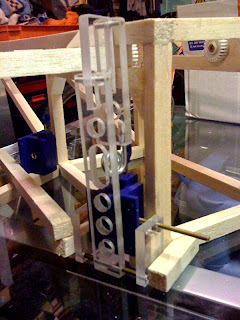I made the adapter cable with the Deans connectors (cut off the end of the umbilical) and 4mm bullets fitted to mate with the Li-Po. I didn't know how charged the battery was, but I had to try it...
With just the battery (no extra weights) I powered up and "hovered" for a minute or so; all 3 EDFs running and plenty of power. I then added the 2 blocks of metal again. These are just bits I've been using to help in the construction so far, as weights or a square-edge. So powering again, it got off the ground but was obviously loaded. Second attempt and it just got off the ground and I hit max on the controller. I backed off, then tried again - now barely lifting. I took off the heavier block and re-tried - only slightly better. The battery must be dead! As I said; I don't know what the state of charge was beforehand and the charger hasn't arrived yet...
Disheartened by the sub-60 second runtime, I was thinking the battery couldn't have been charged. I wasn't expecting much, maybe 2 or 3 minutes. I also thought I should check and quantify the "other stuff", so went off to weigh the 2 blocks. They were a lot heavier than I thought: the larger block of aluminium was 335g and the smaller stainless steel block was 414g! For comparison, the battery is 408g (listed as 412g). That made me feel a little better; I'd added a lot more than necessary, an additional 759g (1.65lb for those working in old money). So fingers-crossed; if I can keep the weight of all that "other stuff" down and with a fully charged battery, it might just work... for a couple of minutes.
With just the battery (no extra weights) I powered up and "hovered" for a minute or so; all 3 EDFs running and plenty of power. I then added the 2 blocks of metal again. These are just bits I've been using to help in the construction so far, as weights or a square-edge. So powering again, it got off the ground but was obviously loaded. Second attempt and it just got off the ground and I hit max on the controller. I backed off, then tried again - now barely lifting. I took off the heavier block and re-tried - only slightly better. The battery must be dead! As I said; I don't know what the state of charge was beforehand and the charger hasn't arrived yet...
Disheartened by the sub-60 second runtime, I was thinking the battery couldn't have been charged. I wasn't expecting much, maybe 2 or 3 minutes. I also thought I should check and quantify the "other stuff", so went off to weigh the 2 blocks. They were a lot heavier than I thought: the larger block of aluminium was 335g and the smaller stainless steel block was 414g! For comparison, the battery is 408g (listed as 412g). That made me feel a little better; I'd added a lot more than necessary, an additional 759g (1.65lb for those working in old money). So fingers-crossed; if I can keep the weight of all that "other stuff" down and with a fully charged battery, it might just work... for a couple of minutes.























